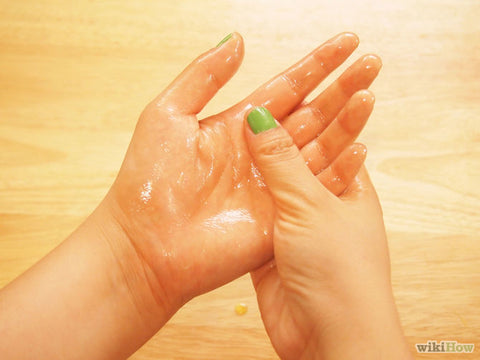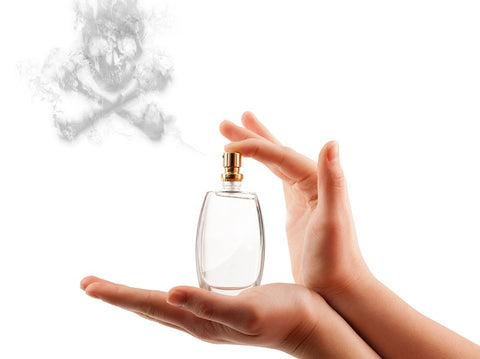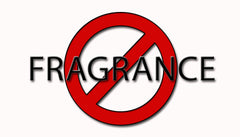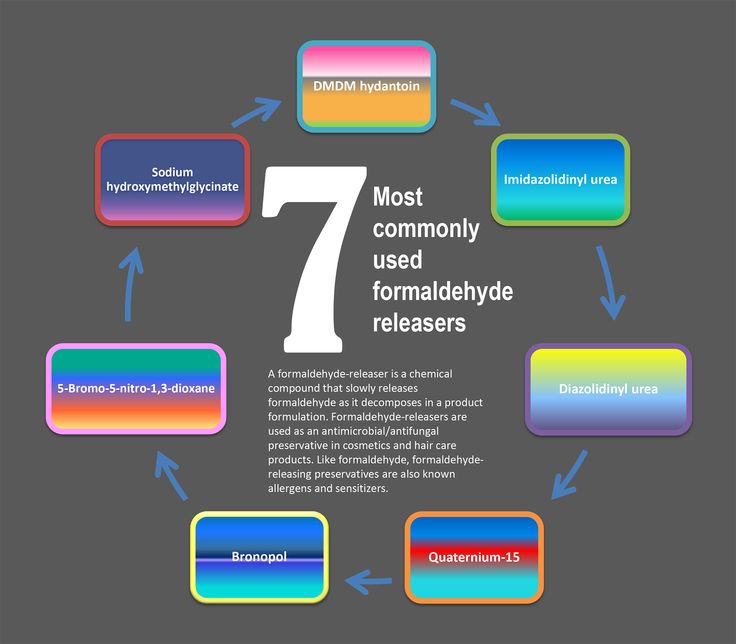-

For many of us in the U.S., this winter has been brutally cold. Tis' the season for dry lips and chapped hands that may even cut open and bleed.
Tip for dry hands or chapped lips:
Squirt a finger-tip amount of AMG Naturally Elixir Oil (containing 2 miracle oils from the Rain Forest) and rub onto dry lips. You will love the way it feels and smells. Do the same on top of your left hand and rub it in with the top of your right hand to avoid getting greasy fingertips. It will absorb fast and leave your hands moist and soft. No need for chemical-laden hand lotions!!
-
Think twice before you buy a loved one PERFUME for Valentine's Day.

Do you love them or do you want to kill them? You might be doing BOTH.
Connie Pitts, author of Get a Whiff of This: Perfumes (Fragrances) - The Invisible Chemical Poisons, explains “Perfumes, colognes, and many other scented products contain an abundance of harmful chemicals, many of which are listed on the EPA’s Hazardous Waste List. They also include numerous carcinogenic chemicals, neurotoxins, respiratory irritants, solvents, aldehydes, hundreds of untested and unregulated petrochemicals, phthalates (which can act as hormone disruptors), narcotics, and much more.”(3)
Petroleum based chemicals in your perfume?!

The Committee on Science & Technology found that roughly 95% of the chemicals used in PERFUME, to make the unique "fragrance", are synthetic compounds derived from petroleum. Petroleum is created as a byproduct in the process of refining crude oil (drilled directly from the earth that is typically converted into gasoline and other fuels). (4) Petroleum based chemicals considerably weaken the nervous systems and immune systems after repeated exposure.
Illnesses identified in medical research...
“Illnesses identified in medical research include adult and child cancers, numerous neurological disorders, immune system weakening, autoimmune disorders, asthma, allergies, infertility, miscarriage, and child behavior disorders including learning disabilities, mental retardation, hyperactivity and ADD (attention deficit disorders).”(5) It is not uncommon for people to use other types of petroleum-based products for a variety of cosmetic purposes such as dry skin and dandruff. A large manufacturer of petroleum based products is planning on greatly expanding its product line in the near future.
Caution to everyone!
We caution everyone to avoid the use of these products as well. READ YOUR LABELS. To learn HOW, sign up for the AMG free NEWSLETTER.
TAKE HOME TIPS:
- Never spray perfume on your skin.
- Spray instead on your clothes and not too close to your NOSE.
- Be aware that others around you are inhaling your perfume too. Lungs are very sensitive to chemicals, especially those of babies and young children, as they cannot detoxify.
-
Author: Linda Lizotte, RD, Nutritionist
Founder and President, AMG Naturally Inc.

What exactly is “Fragrance”?
Adding synthetic fragrances, or perfume, to personal care products is commonplace in the cosmetic industry. “Scented products are generally perceived as pleasant, a harmless means of self-expression and certainly not a significant health concern.”(1) On the contrary, fragrance can be one of the most harmful ingredients in a product. This is mainly due to the fact that fragrance is not simply one ingredient, but a mixture of anywhere from a few dozen chemicals to a few hundred.
Companies use the term “fragrance”, also known, or listed, as “parfum”, to hide the chemical cocktail that is truly contained in their products such as Aveeno’s Positively Radiant Daily Moisturizer. According to federal labeling laws, any ingredients used to give a product a pleasant scent, or mask an unpleasant one, can be listed generically as “fragrance”. To the consumer, this means that companies have no reason to disclose the types of chemicals, or the amount, that they include in their products. (2)
Why is fragrance unhealthy for people?
The International Fragrance Association publishes a Transparency List online. This list is a compilation of over 3,000 specific chemicals that fragrance makers acknowledge using in their formulas. That list can be found HERE.
Connie Pitts, author of Get a Whiff of This: Perfumes (Fragrances) - The Invisible Chemical Poisons, explains “Perfumes, colognes, and many other scented products contain an abundance of harmful chemicals, many of which are listed on the EPA’s Hazardous Waste List. They also include numerous carcinogenic chemicals, neurotoxins, respiratory irritants, solvents, aldehydes, hundreds of untested and unregulated petrochemicals, phthalates (which can act as hormone disruptors), narcotics, and much more.”(3)
The Committee on Science & Technology found that roughly 95% of the chemicals used in fragrance are synthetic compounds derived from petroleum. Petroleum is created as a byproduct in the process of refining crude oil (drilled directly from the earth that is typically converted into gasoline and other fuels). (4) Petroleum based chemicals considerably weaken the nervous systems and immune systems after repeated exposure. “Illnesses identified in medical research include adult and child cancers, numerous neurological disorders, immune system weakening, autoimmune disorders, asthma, allergies, infertility, miscarriage, and child behavior disorders including learning disabilities, mental retardation, hyperactivity and ADD (attention deficit disorders).”(5) It is not uncommon for people to use other types of petroleum based products for a variety of cosmetic purposes such as dry skin. A large manufacturer of petroleum based products is planning on greatly expanding its product line in the near future. We caution everyone to avoid use of these products as well.

Common chemicals found in fragrance:
While it is impossible for us to list all 3,000+ chemicals that can potentially be included under the generalization of fragrance, many of which are banned in Europe due to toxicity, a few of them are:
-Phthalates - Methyl Benzene -Benzene -Acetone
-Galaxolide - Benzyl Acetate -Benzaldehyde -Ethyl Acetate
-Tonalide -Benzyl Alcohol - Styrene - Methylene Chloride
Material Safety Data Sheets confirm that exposure to these chemicals can cause; “central nervous system disorders, dizziness, nausea, uncoordination, slurred speech, drowsiness, irritation to the mouth, throat, eyes, skin, lungs and GI tract, kidney damage, headaches, respiratory (breathing) failure, ataxia (lack of coordination), and fatigue, among other symptoms and illnesses.”(6)
What types of products contain synthetic fragrances?
Synthetic fragrances can be found in almost any type of product today including soap, shampoo, conditioner, lotion, deodorant, perfumes, colognes, household cleaning products, air fresheners, and candles. Even the most careful of consumers would be hard pressed to avoid total exposure from these synthetic fragrances. To protect ourselves from further bodily harm we must remain hyper-vigilant in avoiding these types of products.
Is there any way to know exactly what chemicals we are absorbing through our skin or inhaling when we use products that contain synthetic fragrances?
The most alarming realization for consumers is that there is essentially no way of knowing what chemicals we are exposing ourselves to when we use products containing synthetic fragrances. There is no requirement for disclosing or safety testing any of the ingredients in a fragrance formula before marketing it to the public. “Fragrance formulas are considered ‘trade secrets’ and do not need to be revealed to anyone, including regulatory agencies. “(1) Manufacturers would not want Britney Spears knocking off the same perfume as Jessica Simpson.
The Not Too Pretty report found phthalates in 72 percent of personal care products they analyzed including FRAGRANCE-containing shampoos, deodorants, and hair gels. NONE listed phthalates on their label.
As usual, manufacturers of fragrances will tell us that the amount of chemicals in a product is too insignificant to negatively impact the user. Carrie Loewenherz, an industrial hygienist for the New York Committee for Occupational Safety and Health, warns us “Even if the general population isn’t likely to suffer acute effects from exposure to fragrances, there are long-term chronic health effects connected to these chemicals that we don’t fully understand yet.”(7) So, spray at your own risk! If you insist, spray on your clothes, far from your nose. Remember that your loved ones are inhaling the chemicals too, similar to secondhand smoke, and known to be just as toxic.
With such a clear lack of data on the long-term effects of exposing one’s self to this varying array of chemicals, the only sane course of action would be to avoid them. At AMG Naturally we strongly encourage everyone to read the labels on the products they use in their daily routines and avoid anything that has fragrance listed on the label.

Even if the product is advertised as “fragrance-free” it may still contain a masking fragrance, double check that label. Using products with pleasing aromas and avoiding harmful synthetic fragrances are not mutually exclusive. Stick to products with natural scents and natural ingredients; throw the synthetics in the trash. Choose companies that truly CARE about YOUR SKIN CARE.
Sign up for AMG Naturally’s monthly e-Newsletter to learn how to read tricky cosmetic labels.
References:
- FPINVA, “Fragrances by Design: Materials that quickly get into the air.” Fragranced Products Information Network fpinva.org.
- “Dangers of fragrance: WHY GO FRAGRANCE FREE?” Quantum Growth Business Solutions.
- Pitts, Connie (2003). “Featured Author. Connie Pitts – Get a Whiff of This: Perfumes (Fragrances) – The Invisible Chemical Poisons.” Integrative Ink integrativeink.com.
- S. House of Representatives (Sept. 16, 1986). “Neurotoxins: At Home and the Workplace.” Report by the Committee on Science & Technology, Report 99-827.
- Pressinger, Richard M.Ed and Sinclair, Wayne MD. “Chem-Tox.com: Researching effects of chemicals and pesticides upon health.” Chem-Tox.com chem-tox.com.
- Dewey, David Lawrence (October 7, 1999). “Food For Thought: Colognes – Perfumes – Pesticides Are They Slowly Killing You?” Dewey’s World dldewey.com.
- Lyman, Francesca (Feb. 12, 2003). “What the nose knows – Think twice before buying a loved one perfume, cologne.” MSNBC msn.com/id/3076635/.
-

How does formaldehyde end up in our cosmetic products?
No reasonable person would use personal care products knowing they contain formaldehyde, a know carcinogen. Unfortunately for us, large cosmetic companies have found ways to sneak this harmful chemical into our products. While it is not explicitly stated that our personal care products contain formaldehyde, it is still there. Cosmetic companies include chemicals, known as formaldehyde releasers, to allow their products to contain formaldehyde without the stigma associated with listing formaldehyde on the label. A similar example of sneaking in chemicals is using the word “fragrance” or “parfum” which always contains harmful chemical phthalates, such as DEP and DEHP. These synthetic, man-made, preservatives have been long banned by the EU (European Union) because of their known toxicity.
Common Formaldehyde Releasers Include:
- DMDM Hydantoin
- Imadiazolidinyl Urea
- Diazolidinyl Urea
- Quaternium-15

Cosmetics that contain the following DIRTY 4 preservative ingredients (formaldehyde releasers) will contain formaldehyde.
These chemical preservatives, used as antimicrobial agents (prevent bacterial growth), slowly release formaldehyde over time as they degrade.
What is formaldehyde? Would you want it in your baby’s shampoo?
Formaldehyde is a highly toxic chemical; it is colorless, has a strong odor, and is flammable. It is most commonly known for its use as a preservative in mortuaries and medical laboratories. In other words, it is embalming fluid for cadavers and animals. It must be an effective preservative if it can preserve dead bodies. It doesn’t stop here. Formaldehyde is also used in pressed-wood products, adhesives, germicides, fungicides, and disinfectants. (1)
These harmful substances are commonly found in shampoos, conditioners, facial cleansers, facial moisturizers, anti-aging creams, and body washes.
Read your labels!!

It was not until earlier this year that Johnson & Johnson, after heavy consumer influence, removed formaldehyde and 1,4-dioxane, both known carcinogens, from its “No More Tears” baby shampoo. Over one billion bottles of this shampoo were sold to consumers before these harmful chemicals were removed. According to Heather White, executive director of the Environmental Working Group (EWG), “there was not enough information to know the long-term effects of these chemicals, and there was mounting evidence that cumulative exposure can be dangerous.” Consumers should not expect companies to look out for their best interests and be wary of the chemicals contained in the products they use from day to day.
The "No More Tears" Shampoo, Now With No Formaldehyde
What are the side effects of formaldehyde exposure?
Formaldehyde is recognized by the following groups as a known or probable carcinogen (potentially cancer causing); The Environmental Protection Agency, National Cancer Institute, National Toxicology Program, and the International Agency for Cancer Research. (2),(3) Companies defend their use of the aforementioned ingredients by saying there is no proof of carcinogenicity or toxicity. However, always remember that most of us use multiple products in a given day, so the exposure multiplies with each use. (Soap, shampoo, conditioner, shaving cream, after shave (on open pores and cuts), body scrub, face scrub – please avoid plastic microbeads – more on this later), deodorant, perfume, nail polish, body lotion, hand cream, and anti-aging creams and serums). I am sure you could add your own personal favorites to this list.
Short term formaldehyde exposure symptoms...
Short term formaldehyde exposure from our personal care products can also cause the following symptoms, through skin contact and vapor inhalation:
- Allergic contact dermatitis
- General skin irritation
- Burning of the throat, nose, and eyes (No More Tears???)
- Watery eyes
- Headaches
- Nausea
Steps should be taken to avoid all personal products that contain any of these listed formaldehyde releasers. Women should be especially careful to avoid formaldehyde containing products. Formaldehyde contact allergy is more common in women then men, according to studies done by the Swedish Contact Dermatitis
Group. (6) There is no way for a consumer to know how much formaldehyde is being released into their products or the compound effect of multiple products they use that expose them to formaldehyde.
_______________________________________________________
AMG Naturally Inc. anti-aging products are guaranteed chemical-free and NEVER contain formaldehyde releasers.
_______________________________________________________
References
- "Formaldehyde and Cancer Risk." National Cancer Institute. N.p., 10 June 2011. Web. 21 Aug. 2014.
- International Agency for Research on Cancer (June 2004). IARC Monographs on the Evaluation of Carcinogenic Risks to Humans Volume 88 (2006): Formaldehyde, 2-Butoxyethanol and 1-tert-Butoxypropan-2-ol. Retrieved June 10, 2011, from: http://monographs.iarc.fr/ENG/Monographs/vol88/index.php .
- National Toxicology Program (June 2011). Report on Carcinogens, Twelfth Edition. Department of Health and Human Services, Public Health Service, National Toxicology Program. Retrieved June 10, 2011, from: http://ntp.niehs.nih.gov/go/roc12.
- Laskin, S., M. Kuschner, R.P. Drew, V.P. Capiello, and N. Nelson: Tumors of Respiratory Tract Induced by Inhalation of Bis-(chloro-methyl)Ether, Arch. Enviro. Health 23:135-136 (1971)
- Proctor, N.H., and J.P. Hughes: Chemical Hazards of the Workplace. J.B. Lippincott, Philadelphia, pp. 272-274 (1978).
- Cronin E. Formaldehyde is a significant allergen in women with hand eczema. Contact Dermatitis 1991 ; 25: 276-282.
-
Are you donating money to the pink ribbon foundation for breast cancer?
Remember that your dollar is your vote. After reading this you may want to put your money where it counts.
A pharmaceutical company called AstraZeneca is a leading manufacturer of agricultural chemicals worldwide including carcinogenic pesticides. They also produce the drug Tamoxifen. They intelligently co-founded the pink ribbon foundation knowing they are making money off Tamoxifen, the number one prescribed drug for breast cancer. Notice the foundation only touts increasing awareness and finding a cure. After all, how can they support prevention when they are somewhat guilty of causing the disease?This is the same company that dumped DDT and PCBs into the Los Angeles and Long Beach harbors in 1990 when it was owned by Imperial Chemical Industries, a multi-billion-dollar manufacturer of pesticides, paper, and plastics. Nice.It gets worse...
Breast cancer diagnoses are on the rise and especially in younger women in their 20s and 30s. This same company, the world's biggest manufacturer of chemicals, went on to buy up the cancer center treatments in America. They also have control over research which is where your money is supposed to be going. Do they really want a cure or do they want to sell more Tamoxifen?Are your cosmetics hurting you?
Estée Lauder is a big financial supporter of the pink ribbon. Why? Advertising exposure? They managed to remove chemicals, such as parabens and phthalates, (their cosmetics are loaded with the ingredients on the DO not contain list you see on the AMG label and website) from their cosmetics for sale in Europe, who banned them, but refuse to take them out of the products they sell in the U.S. This could only be about larger profits, and a lack of conscience. Why is the U.S. not banning the same ingredients? That is for another blog.Meanwhile, let's work together to increase education so we are spending our money wisely and improving the health of women and girls rather than contributing to its decline. -

Neutrogena? Hmmm. Notice the dark color of the shampoo above..yes it is from the coal tar ingredient in this shampoo…and the smell makes you hold your nose like you are walking through a coal manufacturing facility.
Look for any of the following words that all mean the same thing: TOXIN!!!!!
Coal tar solution, tar, coal, carbo-cort, coal tar solution USP, crude coal tar, estar, impervotar, KC 261, lavatar, picis carbonis, naphtha, high solvent naphtha, naphtha distillate, benzin B70, petroleum benzin [1,2]
What is this stuff???

Coal tar is a known carcinogen derived from burning coal. It is a complex mixture of hundreds of compounds, many of which are polycyclic aromatic hydrocarbons (PAHs) [3,4]. Coal tar is used in food, textiles, cosmetics and personal care products.
Experimental studies have found that application of and exposure to coal tar can lead to skin tumors, cancer, organ system damage and neurological damage. Many people are rubbing this on their head which easily allows for direct access to their brain!!!
What are the health concerns?
Cancer: Experimental studies have found that exposure to and application of coal tar produce skin tumors. Coal tar has also been associated with cancer of the lung, bladder, kidney and digestive tract [5,6]. Benzo[a]pyrene, a constituent of coal tar, has been found to be carcinogenic through skin exposure [7,6]. There have been many reports of skin cancer among patients using therapeutic coal-tar preparations [5].
Organ System Toxicity: Pyridine, a coal tar constituent, has been linked to neurological damage. Effects include emotional and sleep disturbances, as well as loss of coordination [8,9].
If you are using coal tar-containing shampoo or naphtha soap – throw them away!!
AMG Naturally does not yet sell shampoo or soap. When we are done with our research and have formulated the most hair and scalp- loving a shampoo that smells natural, is natural, and really works amazingly then you can buy it from AMG.

References:
- Coal Tar. Environmental Working Group’s Skin Deep cosmetic safety database. Available Online: http://www.ewg.org/skindeep/ingredient/701514/COAL_TAR/
- Don’t use food or products made with coal tar dyes. March 2013. Available Online: http://healthychild.org/easy-steps/dont-use-products-made-with-coal-tar-dyes/. Accessed November 5, 2013.
- Marston, C. P., Pereira, C., Ferguson, J., Fischer, K., Hedstrom, O., Dashwood, W. M., & Baird, W. M. (2001). Effect of a complex environmental mixture from coal tar containing polycyclic aromatic hydrocarbons (PAH) on the tumor initiation, PAH–DNA binding and metabolic activation of carcinogenic PAH in mouse epidermis. Carcinogenesis, 22(7), 1077-1086.
- Thomas, P. Behind the Label: Head and Shoulders classic clean (July 2008). Available Online: http://www.theecologist.org/green_green_living/behind_the_label/269804/behind_the_label_head_and_shoulders_classic_clean.html
- Coal Tar. Report on carcinogens 12 edition. Available Online: http://ntp.niehs.nih.gov/?objectid=03C9AF75-E1BF-FF40-DBA9EC0928DF8B15
- Bonner, M. R., Han, D., Nie, J., Rogerson, P., Vena, J. E., Muti, P., ... & Freudenheim, J. L. (2005). Breast cancer risk and exposure in early life to polycyclic aromatic hydrocarbons using total suspended particulates as a proxy measure. Cancer Epidemiology Biomarkers & Prevention, 14(1), 53-60.
- Fysh, J. M., Andrews, L. S., Pohl, L. R., & Nebert, D. W. (1980). Differing degrees of coal-tar shampoo-induced mutagenesis in the Salmonella/liver test system in vitro. Pharmacology, 20(1), 1-8.
- Pirydine. Material Data Safety Sheet. Available Online: http://www.mathesongas.com/pdfs/msds/MAT19990.pdf. Accessed November 5, 2013
- Pinsky, C., & Bose, R. (1988). Pyridine and other coal tar constituents as free radical-generating environmental neurotoxicants.Molecular and cellular biochemistry, 84(2), 217-222




















